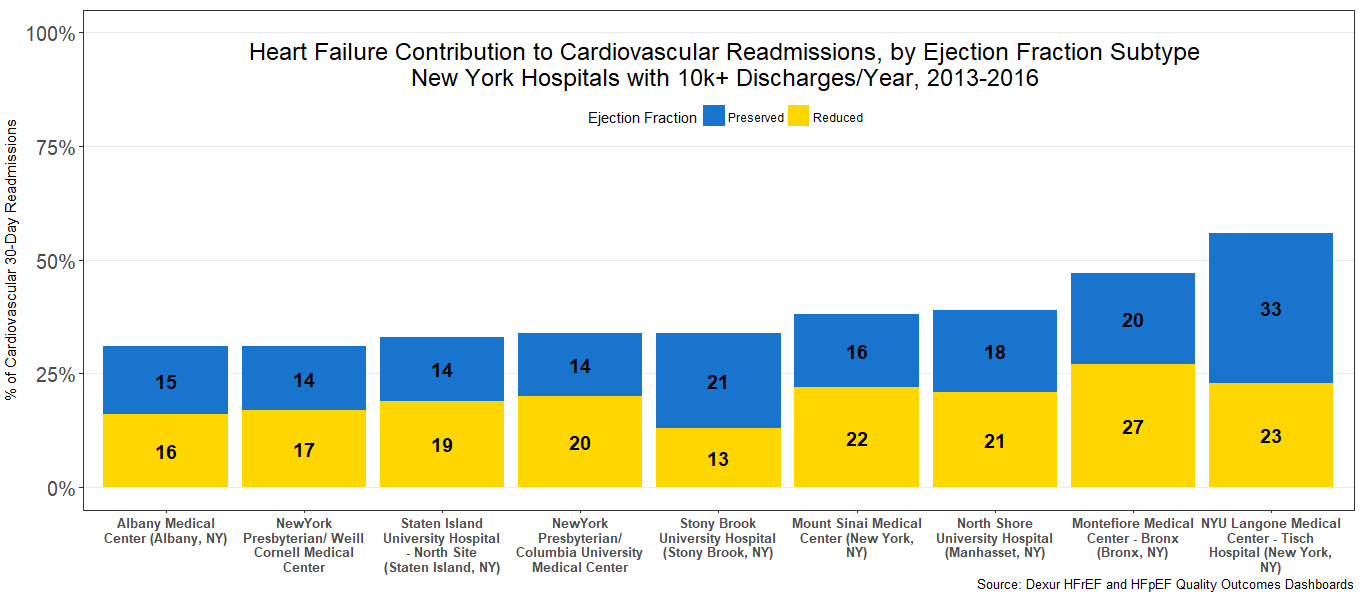At Stony Brook Hospital, High Proportion of Preserved Ejection Fraction in Heart Failure Readmissions
In Heart Failure
Get Dexur’s Personalized Hospital Specific Presentation on Quality, Safety, Compliance & Education
By: James Pitt Jul. 06, 2018
Heart failure can be classified by ejection fraction. In heart failure with reduced ejection fraction (HFrEF, aka LVEF), the left ventricle pumps out an unusually low fraction of the blood that enters it. HFrEF has been a focus of research efforts, because most studies find it is associated with higher mortality than heart failure with preserved ejection fraction (HFpEF).
However, HFpEF is currently receiving renewed research attention, because some therapies that improve HFrEF outcomes fail in HFpEF.
ECG may play an important role in determining patient prognosis. A May 2017 study of 6664 patients, published in Journal of the American Heart Association, found that different ECG markers predict later heart failure in HFrEF and HFpEF. A June 2018 report in Journal of Cardiovascular Electrophysiology and a 2016 study in AE Press found that different ECG markers predicted mortality in readmission in HFrEF vs in HFpEF patients.
Dexur analysts examined 30-day readmissions at New York hospitals with over 10,000 CMS inpatient discharges per year. CMS uses 30-day readmissions as an indicator of quality of care. The relative contributions of HFrEF and HFpEF to total cardiovascular readmissions varied across hospitals.

Heart failure accounted for 56% of cardiovascular readmissions at NYU Langone Medical Center - Tisch Hospital, with 33% involving preserved ejection fraction and 23% involving reduced ejection fraction. Heart failure contributed least to cardiovascular readmissions at Albany Medical Center, where 31% of heart failure readmissions involved heart failure (15% HFpEF, 16% HFpEF).
HFpEF made up an unusually large proportion of heart failure readmissions at Stony Brook University Hospital, where 21% of 30-day heart failure readmissions involved HFpEF and 13% involved HFrEF.
Hospitals varied widely in the relative contributions of HFrEF and HFpEF to readmissions. Because HFrEF and HFpEF have different prognoses, hospitals may benefit by identifying which subtype plays a larger role in their cardiovascular readmissions totals.
DEXUR PRO MEMBERS GET ACCESS TO:
- Total Discharges ( Jan 2013 to Dec 2016 )
- Total Discharges After Exclusion
- All Cause 30 Day Readmissions
- 30 Day hfXeF Readmissions
- 30 Day hfXeF Readmission Rate (%)
- State 30 Day hfXeF Readmission Rate (%)
- National 30 Day hfXeF Readmission Rate (%)
- % 30 Day Readmissions back to Same Hospital
- 30 to 60 Day hfXeF Readmissions
- 30 to 60 Day hfXeF Readmission Rate (%)
- State 30 to 60 Day hfXeF Readmission Rate (%)
- National 30 to 60 Day hfXeF Readmission Rate (%)
For HFrEF and HFpEF at the following hospitals:
- North Shore University Hospital (Manhasset, NY)
- Montefiore Medical Center - Bronx (Bronx, NY)
- NewYork Presbyterian/ Weill Cornell Medical Center
- Mount Sinai Medical Center (New York, NY)
- NewYork Presbyterian/ Columbia University Medical Center
- NYU Langone Medical Center - Tisch Hospital (New York, NY)
- Albany Medical Center (Albany, NY)
- Stony Brook University Hospital (Stony Brook, NY)
- Staten Island University Hospital - North Site (Staten Island, NY)
ABOUT THE AUTHOR
